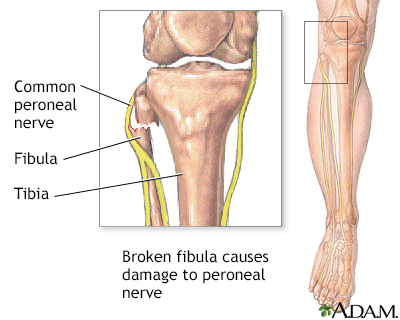Pregnancy SmartSiteTM
Peroneal nerve injury - foot drop; Fibular nerve injury; Foot drop palsy; Fibular neuropathy; Peroneal neuropathy; Drop foot DefinitionFoot drop is when you have difficulty lifting the front part of your foot. This may cause you to drag your foot when you walk. Foot drop, also called drop foot, can be caused by a problem with the muscles, nerves, or anatomy of your foot or leg. CausesFoot drop is not a condition by itself. It is a symptom of another disorder. Foot drop can be caused by a number of health conditions. The most common cause of foot drop is peroneal nerve injury. This nerve is also called the fibular nerve is a branch of the sciatic nerve. It supplies movement and sensation to the lower leg, foot, and toes. Conditions that affect the nerves and muscles in the body can lead to foot drop. They include:
Crossing the legs at the knees can also damage the peroneal nerve. Brain and spinal cord disorders can cause muscle weakness and paralysis and include: SymptomsFoot drop can cause problems walking. Because you can't raise the front of your foot, you need to raise your leg higher than normal to take a step to avoid dragging your toes or tripping. The foot may make a slapping noise as it hits the ground. This is called a steppage gait. Depending on the cause of foot drop, you may feel numbness or tingling on the top of your foot or shin. Foot drop may occur in one or both feet, depending on the cause. Exams and TestsYour health care provider will perform a physical exam, which may show:
Your provider may order one or more of the following tests to check your muscles and nerves and to determine the cause:
TreatmentTreatment of foot drop depends on what is causing it. In some cases, treating the cause will also cure foot drop. If the cause is a chronic or ongoing illness, foot drop may be permanent. Certain people may benefit from physical and occupational therapy. Possible treatments include:
Surgery may be needed to relieve pressure on the nerve or to try to repair it. For long-term foot drop, your provider may suggest fusing the ankle or foot bones. Or you may have tendon surgery. In this, a working tendon and attached muscle is transferred to a different part of the foot. Outlook (Prognosis)How well you recover depends on what is causing foot drop. Foot drop will often go away completely. If the cause is more severe, such as stroke, you may not recover completely. When to Contact a Medical ProfessionalContact your provider if you have trouble walking or controlling your foot, including:
ReferencesDel Toro DR, Seslija D, King JC. Fibular (peroneal) neuropathy. In: Frontera WR, Silver JK, Rizzo TD, eds. Essentials of Physical Medicine and Rehabilitation. 4th ed. Philadelphia, PA: Elsevier; 2019:chap 75. Katirji B. Disorders of peripheral nerves. In: Jankovic J, Mazziotta JC, Pomeroy SL, Newman NJ, eds. Bradley and Daroff's Neurology in Clinical Practice. 8th ed. Philadelphia, PA: Elsevier; 2022:chap 106. Thompson PD, Nutt JG. Gait disorders. In: Jankovic J, Mazziotta JC, Pomeroy SL, Newman NJ, eds. Bradley and Daroff's Neurology in Clinical Practice. 8th ed. Philadelphia, PA: Elsevier; 2022:chap 25. | |
| |
Review Date: 4/29/2023 Reviewed By: Joseph V. Campellone, MD, Department of Neurology, Cooper Medical School of Rowan University, Camden, NJ. Review provided by VeriMed Healthcare Network. Also reviewed by David C. Dugdale, MD, Medical Director, Brenda Conaway, Editorial Director, and the A.D.A.M. Editorial team. The information provided herein should not be used during any medical emergency or for the diagnosis or treatment of any medical condition. A licensed medical professional should be consulted for diagnosis and treatment of any and all medical conditions. Links to other sites are provided for information only -- they do not constitute endorsements of those other sites. No warranty of any kind, either expressed or implied, is made as to the accuracy, reliability, timeliness, or correctness of any translations made by a third-party service of the information provided herein into any other language. © 1997- A.D.A.M., a business unit of Ebix, Inc. Any duplication or distribution of the information contained herein is strictly prohibited. | |

 Common peroneal ne...
Common peroneal ne...
